Abstract
Thiorphan, N-[(R,S)-3-mercapto-2-benzylpropanoyl]glycine is a highly potent inhibitor (Ki = 3.5 nM) of "enkephalinase," a metalloendopeptidase cleaving the Gly-Phe bond (positions 3 and 4) of enkephalins in brain tissue. In accordance with this property, thiorphan displays antinociceptive activity after systemic administration. However, thiorphan also inhibits to a lesser extent (Ki = 140 nM) the widely distributed angiotensin-converting enzyme, a carboxydipeptidase implicated in blood pressure regulation. Therefore, in view of an eventual clinical use of enkephalinase inhibitors, it was very important to develop fully specific compounds. Such derivatives were obtained taking into account that N-methylation of the ultimate amide bond of dipeptides strongly decreases enkephalinase affinity without affecting angiotension-converting enzyme recognition, whereas retro-inversion of the amide bond leads to the inverse effect. Thus, the retro-inverso dipeptide (R)-H2N-CH(CH2 phi)-NHCO-CH2-CO2H exhibits an inhibitory potency on enkephalinase (IC50 approximately equal to 12 muM) close to that of the natural dipeptide L-Phe-Gly (IC50 approximately equal to 3 muM). This result shows the topological analogy between the crucial components involved in enkephalinase recognition both in active dipeptides and structurally related retro-inverso isomers. Taking into account these observations, retro-thiorphan, (R,S)-HS-CH2-CH-(CH2 phi)-NHCO-CH2-COOH, was prepared. As compared to thiorphan, the retro isomer is 50% as potent (Ki = 6 nM) on enkephalinase but displays a drastic loss of potency on angiotension-converting enzyme (IC50 greater than 10,000 nM). This specificity was interpreted as a consequence of differences in the stereochemical constraints involving enzyme-inhibitor hydrogen bonding. This hypothesis is supported by reported crystallographic studies on related enzymes such as thermolysin and carboxypeptidase A. As expected, retro-thiorphan exhibits about the same analgesic potency as thiorphan on the hot plate and writhing tests in mice. Therefore, the topological concept of retro-inverso isomers could be extended to other enkephalinase inhibitors, allowing the design of potent and highly selective compounds occurring as new classes of analgesic and psychoactive agents.
Full text
PDF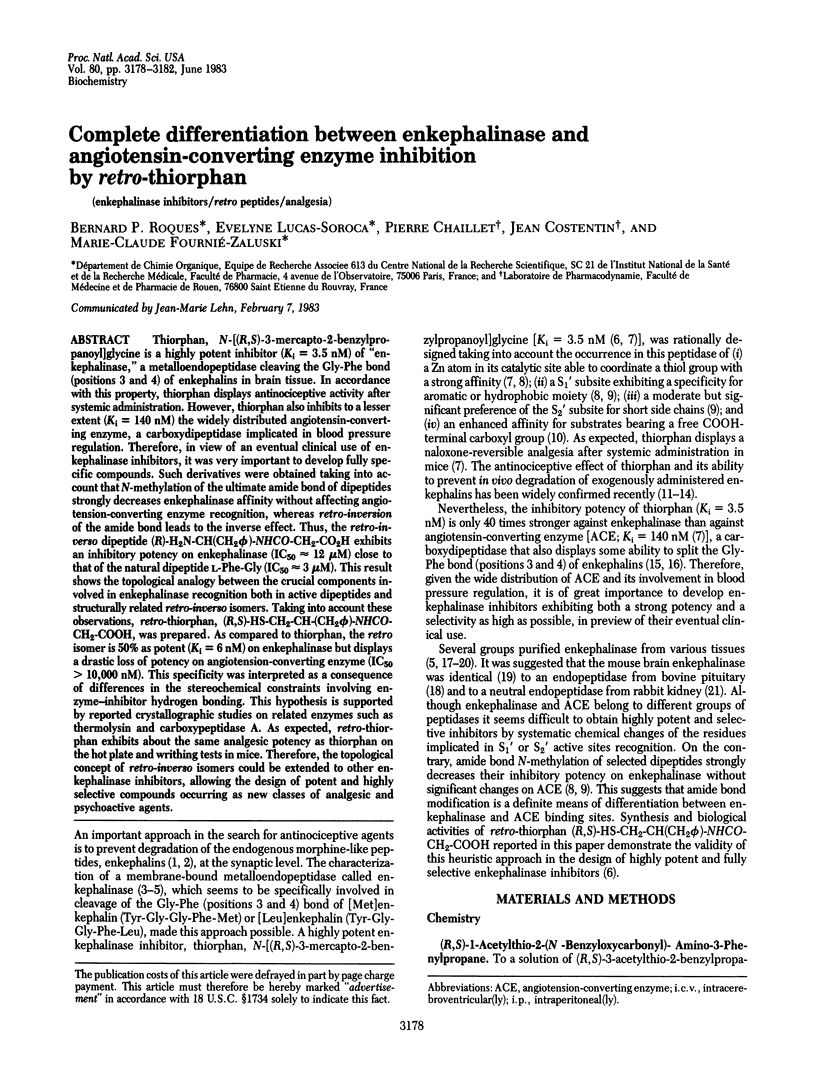
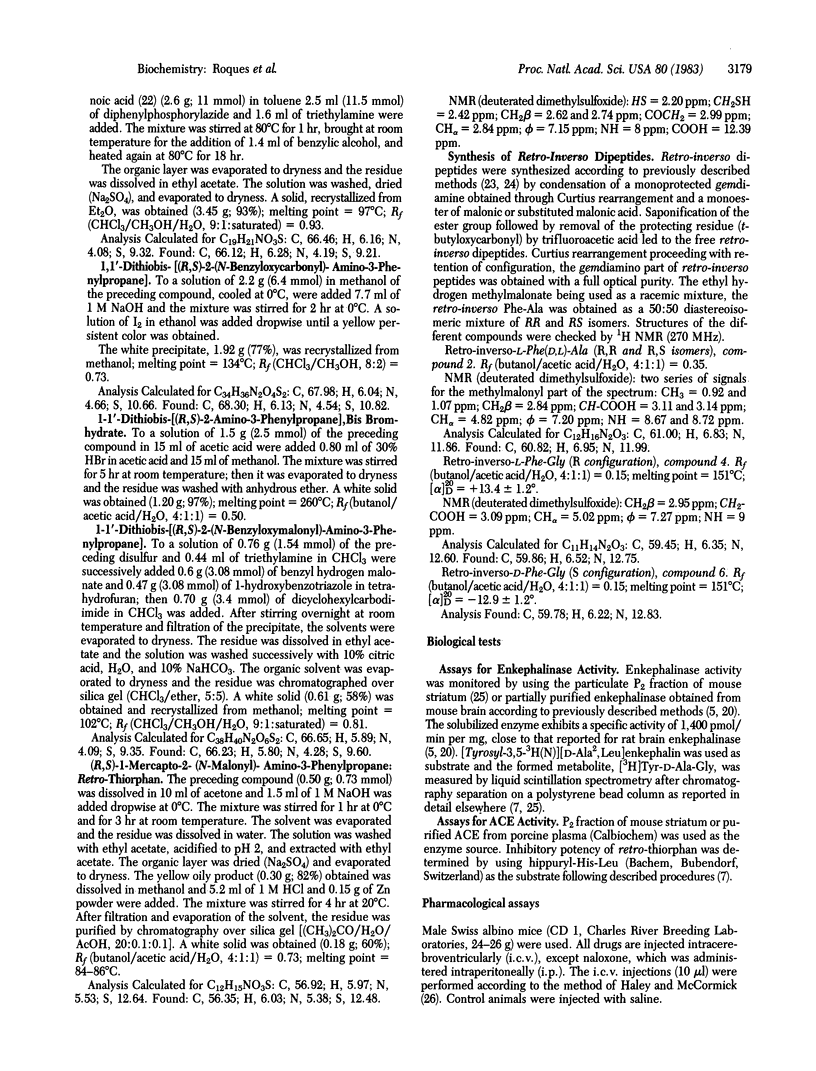
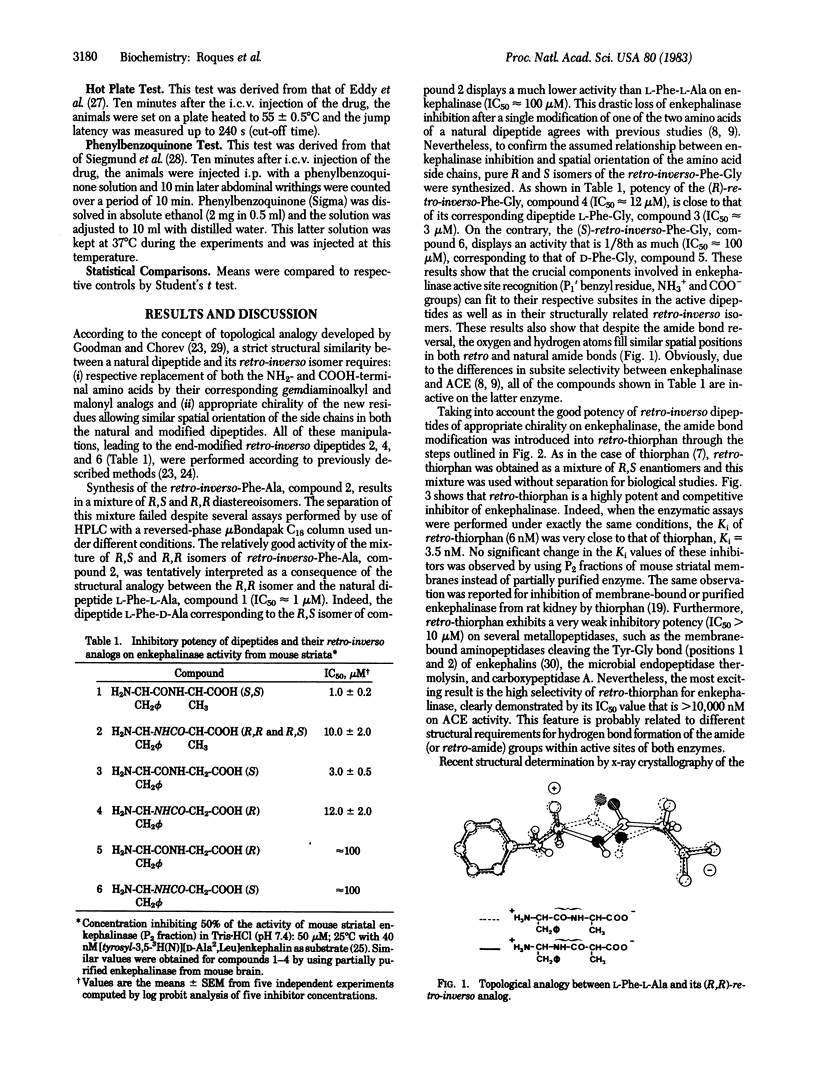
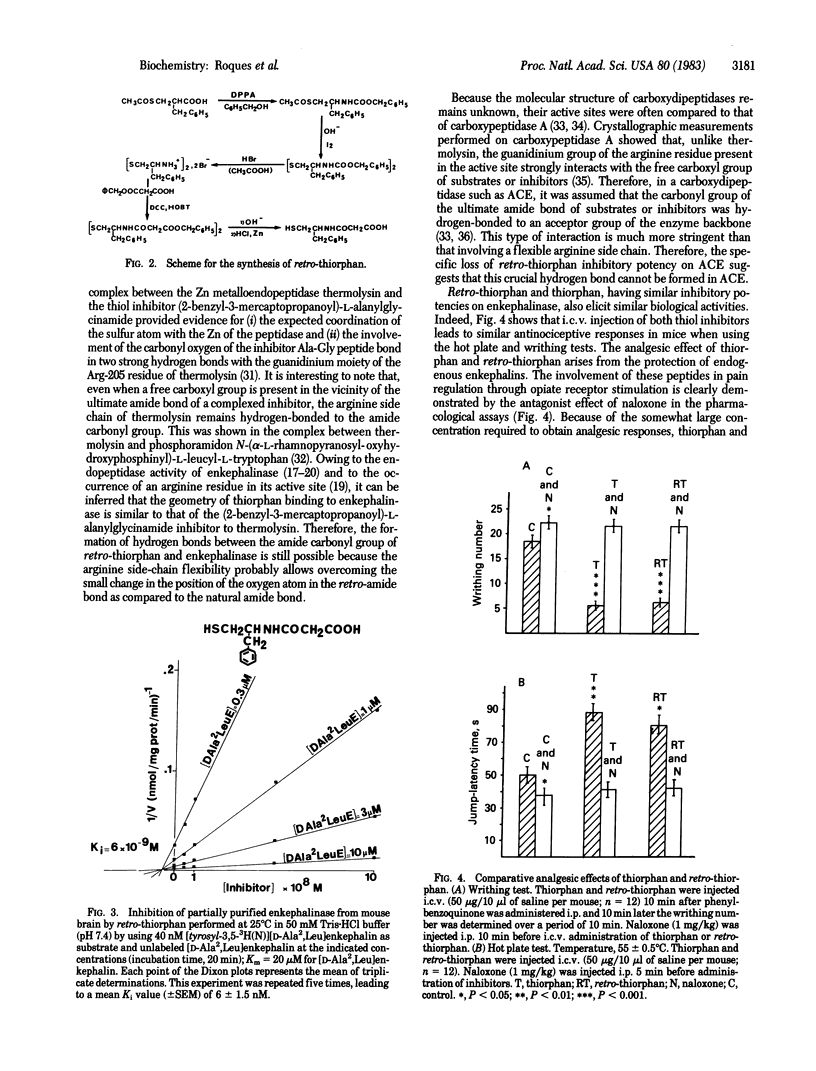
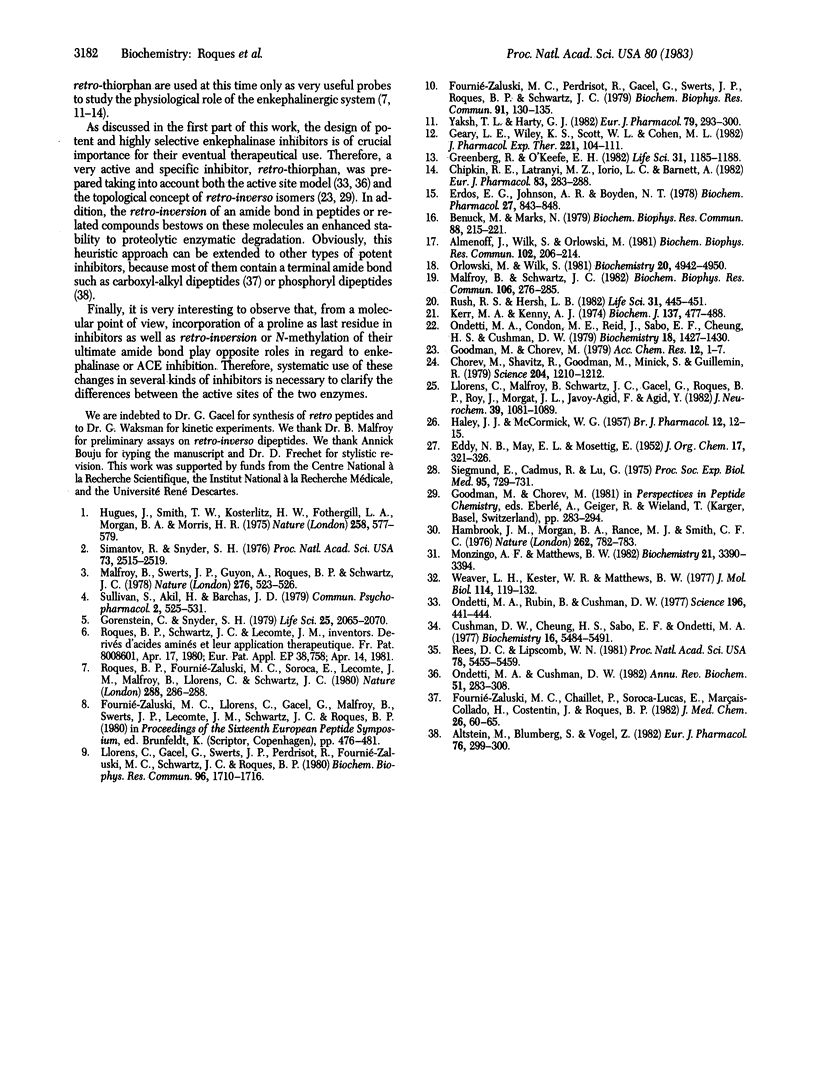
Selected References
These references are in PubMed. This may not be the complete list of references from this article.
- Almenoff J., Wilk S., Orlowski M. Membrane bound pituitary metalloendopeptidase: apparent identity to enkephalinase. Biochem Biophys Res Commun. 1981 Sep 16;102(1):206–214. doi: 10.1016/0006-291x(81)91508-4. [DOI] [PubMed] [Google Scholar]
- Altstein M., Blumberg S., Vogel Z. Phosphoryl-Leu-Phe: a potent inhibitor of the degradation of enkephalin by enkephalinase. Eur J Pharmacol. 1981 Dec 3;76(2-3):299–300. doi: 10.1016/0014-2999(81)90520-3. [DOI] [PubMed] [Google Scholar]
- Benuck M., Marks N. Co-identity of brain angiotensin converting enzyme with a membrane bound dipeptidyl carboxypeptidase inactivating Met - enkephalin. Biochem Biophys Res Commun. 1979 May 14;88(1):215–221. doi: 10.1016/0006-291x(79)91718-2. [DOI] [PubMed] [Google Scholar]
- Chipkin R. E., Latranyi M. Z., Iorio L. C., Barnett A. Potentiation of [D-ala2]enkephalinamide analgesia in rats by thiorphan. Eur J Pharmacol. 1982 Sep 24;83(3-4):283–288. doi: 10.1016/0014-2999(82)90262-x. [DOI] [PubMed] [Google Scholar]
- Chorev M., Shavitz R., Goodman M., Minick S., Guillemin R. Partially modified retro-inverso-enkephalinamides: topochemical long-acting analogs in vitro and in vivo. Science. 1979 Jun 15;204(4398):1210–1212. doi: 10.1126/science.451565. [DOI] [PubMed] [Google Scholar]
- Cushman D. W., Cheung H. S., Sabo E. F., Ondetti M. A. Design of potent competitive inhibitors of angiotensin-converting enzyme. Carboxyalkanoyl and mercaptoalkanoyl amino acids. Biochemistry. 1977 Dec 13;16(25):5484–5491. doi: 10.1021/bi00644a014. [DOI] [PubMed] [Google Scholar]
- Erdös E. G., Johnson A. R., Boyden N. T. Hydrolysis of enkephalin by cultured human endothelial cells and by purified peptidyl dipeptidase. Biochem Pharmacol. 1978 Mar 1;27(5):843–848. doi: 10.1016/0006-2952(78)90542-7. [DOI] [PubMed] [Google Scholar]
- Fournie-Zaluski M. C., Perdrisot R., Gacel G., Swerts J. P., Roques B. P., Schwartz J. C. Inhibitory potency of various peptides on enkephalinase activity from mouse striatum. Biochem Biophys Res Commun. 1979 Nov 14;91(1):130–135. doi: 10.1016/0006-291x(79)90593-x. [DOI] [PubMed] [Google Scholar]
- Fournié-Zaluski M. C., Chaillet P., Soroca-Lucas E., Marçais-Collado H., Costentin J., Roques B. P. New carboxyalkyl inhibitors of brain enkephalinase: synthesis, biological activity, and analgesic properties. J Med Chem. 1983 Jan;26(1):60–65. doi: 10.1021/jm00355a013. [DOI] [PubMed] [Google Scholar]
- Geary L. E., Wiley K. S., Scott W. L., Cohen M. L. Degradation of exogenous enkephalin in the guinea-pig ileum: relative importance of aminopeptidase, enkephalinase and angiotensin converting enzyme activity. J Pharmacol Exp Ther. 1982 Apr;221(1):104–111. [PubMed] [Google Scholar]
- Gorenstein C., Snyder S. H. Two distinct enkephalinases: solubilization, partial purification and separation from angiotensin converting enzyme. Life Sci. 1979 Dec 10;25(24-25):2065–2070. doi: 10.1016/0024-3205(79)90198-x. [DOI] [PubMed] [Google Scholar]
- Greenberg R., O'Keefe E. H. Thiorphan potentiation of stress-induced analgesia in the mouse. Life Sci. 1982 Sep 20;31(12-13):1185–1188. doi: 10.1016/0024-3205(82)90338-1. [DOI] [PubMed] [Google Scholar]
- HALEY T. J., MCCORMICK W. G. Pharmacological effects produced by intracerebral injection of drugs in the conscious mouse. Br J Pharmacol Chemother. 1957 Mar;12(1):12–15. doi: 10.1111/j.1476-5381.1957.tb01354.x. [DOI] [PMC free article] [PubMed] [Google Scholar]
- Hambrook J. M., Morgan B. A., Rance M. J., Smith C. F. Mode of deactivation of the enkephalins by rat and human plasma and rat brain homogenates. Nature. 1976 Aug 26;262(5571):782–783. doi: 10.1038/262782a0. [DOI] [PubMed] [Google Scholar]
- Hughes J., Smith T. W., Kosterlitz H. W., Fothergill L. A., Morgan B. A., Morris H. R. Identification of two related pentapeptides from the brain with potent opiate agonist activity. Nature. 1975 Dec 18;258(5536):577–580. doi: 10.1038/258577a0. [DOI] [PubMed] [Google Scholar]
- Kerr M. A., Kenny A. J. The purification and specificity of a neutral endopeptidase from rabbit kidney brush border. Biochem J. 1974 Mar;137(3):477–488. doi: 10.1042/bj1370477. [DOI] [PMC free article] [PubMed] [Google Scholar]
- Llorens C., Gacel G., Swerts J. P., Perdrisot R., Fournie-Zaluski M. C., Schwartz J. C., Roques B. P. Rational design of enkephalinase inhibitors: substrate specificity of enkephalinase studied from inhibitory potency of various dipeptides. Biochem Biophys Res Commun. 1980 Oct 31;96(4):1710–1716. doi: 10.1016/0006-291x(80)91371-6. [DOI] [PubMed] [Google Scholar]
- Llorens C., Malfroy B., Schwartz J. C., Gacel G., Roques B. P., Roy J., Morgat J. L., Javoy-Agid F., Agid Y. Enkephalin dipeptidyl carboxypeptidase (enkephalinase) activity: selective radioassay, properties, and regional distribution in human brain. J Neurochem. 1982 Oct;39(4):1081–1089. doi: 10.1111/j.1471-4159.1982.tb11500.x. [DOI] [PubMed] [Google Scholar]
- Malfroy B., Schwartz J. C. Properties of "enkephalinase" from rat kidney: comparison of dipeptidyl-carboxypeptidase and endopeptidase activities. Biochem Biophys Res Commun. 1982 May 31;106(2):276–285. doi: 10.1016/0006-291x(82)91106-8. [DOI] [PubMed] [Google Scholar]
- Malfroy B., Swerts J. P., Guyon A., Roques B. P., Schwartz J. C. High-affinity enkephalin-degrading peptidase in brain is increased after morphine. Nature. 1978 Nov 30;276(5687):523–526. doi: 10.1038/276523a0. [DOI] [PubMed] [Google Scholar]
- Monzingo A. F., Matthews B. W. Structure of a mercaptan-thermolysin complex illustrates mode of inhibition of zinc proteases by substrate-analogue mercaptans. Biochemistry. 1982 Jul 6;21(14):3390–3394. doi: 10.1021/bi00257a022. [DOI] [PubMed] [Google Scholar]
- Ondetti M. A., Condon M. E., Reid J., Sabo E. F., Cheung H. S., Cushman D. W. Design of potent and specific inhibitors of carboxypeptidases A and B. Biochemistry. 1979 Apr 17;18(8):1427–1430. doi: 10.1021/bi00575a006. [DOI] [PubMed] [Google Scholar]
- Ondetti M. A., Cushman D. W. Enzymes of the renin-angiotensin system and their inhibitors. Annu Rev Biochem. 1982;51:283–308. doi: 10.1146/annurev.bi.51.070182.001435. [DOI] [PubMed] [Google Scholar]
- Ondetti M. A., Rubin B., Cushman D. W. Design of specific inhibitors of angiotensin-converting enzyme: new class of orally active antihypertensive agents. Science. 1977 Apr 22;196(4288):441–444. doi: 10.1126/science.191908. [DOI] [PubMed] [Google Scholar]
- Orlowski M., Wilk S. Purification and specificity of a membrane-bound metalloendopeptidase from bovine pituitaries. Biochemistry. 1981 Aug 18;20(17):4942–4950. doi: 10.1021/bi00520a021. [DOI] [PubMed] [Google Scholar]
- Rees D. C., Lipscomb W. N. Binding of ligands to the active site of carboxypeptidase A. Proc Natl Acad Sci U S A. 1981 Sep;78(9):5455–5459. doi: 10.1073/pnas.78.9.5455. [DOI] [PMC free article] [PubMed] [Google Scholar]
- Roques B. P., Fournié-Zaluski M. C., Soroca E., Lecomte J. M., Malfroy B., Llorens C., Schwartz J. C. The enkephalinase inhibitor thiorphan shows antinociceptive activity in mice. Nature. 1980 Nov 20;288(5788):286–288. doi: 10.1038/288286a0. [DOI] [PubMed] [Google Scholar]
- Rush R. S., Hersh L. B. Multiple molecular forms of rat brain enkephalinase. Life Sci. 1982 Aug 2;31(5):445–451. doi: 10.1016/0024-3205(82)90329-0. [DOI] [PubMed] [Google Scholar]
- SIEGMUND E., CADMUS R., LU G. A method for evaluating both non-narcotic and narcotic analgesics. Proc Soc Exp Biol Med. 1957 Aug-Sep;95(4):729–731. doi: 10.3181/00379727-95-23345. [DOI] [PubMed] [Google Scholar]
- Simantov R., Snyder S. H. Morphine-like peptides in mammalian brain: isolation, structure elucidation, and interactions with the opiate receptor. Proc Natl Acad Sci U S A. 1976 Jul;73(7):2515–2519. doi: 10.1073/pnas.73.7.2515. [DOI] [PMC free article] [PubMed] [Google Scholar]
- Sullivan S., Akil H., Barchas J. D. In vitro degradation of enkephalin: evidence for cleavage at the Gly-Phe bond. Commun Psychopharmacol. 1978;2(6):525–531. [PubMed] [Google Scholar]
- Weaver L. H., Kester W. R., Matthews B. W. A crystallographic study of the complex of phosphoramidon with thermolysin. A model for the presumed catalytic transition state and for the binding of extended substances. J Mol Biol. 1977 Jul;114(1):119–132. doi: 10.1016/0022-2836(77)90286-8. [DOI] [PubMed] [Google Scholar]
- Yaksh T. L., Harty G. J. Effects of thiorphan on the antinociceptive actions of intrathecal [D-Ala2,Met5] enkephalin. Eur J Pharmacol. 1982 Apr 23;79(3-4):293–300. doi: 10.1016/0014-2999(82)90635-5. [DOI] [PubMed] [Google Scholar]


